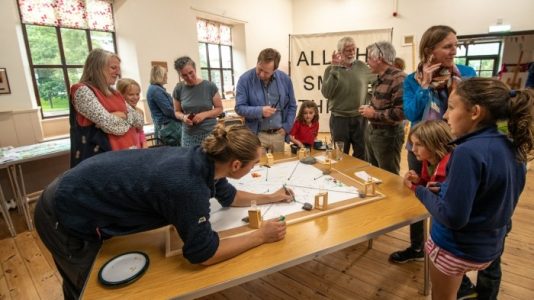Widgetized Section
Go to Admin » Appearance » Widgets » and move Gabfire Widget: Social into that MastheadOverlay zone
Public Administration: “What-Else Mapping”
The views expressed are those of the author and do not necessarily reflect the views of ASPA as an organization.
By Marvin N. Pichla
May 2, 2025

Partnership building is a key principle in maximizing success in the professional field of public administration. “No one goes it alone” in identifying and planning for public service needs locally, regionally, statewide or nationally. Creating and adapting to a common process for future endeavors and actions may seem like a natural, understandable, progressive function that everyone would want to be a part of… right? Well, we all know that history has shown there is NOT one perfect “get-along” option or answer. However, it is necessary for all to continually attempt alternative collaborative concepts that make partnershiping a standard operating procedure within every level of public administration.
In response to this ever-growing need for an enhanced partnership and networking tool… I believe an opportunity worth considering/introducing may be: Public Administration: “What-Else Mapping.” What-Else Mapping is an innovative spin-off of the often-used community or business development Resource Mapping strategy. For reference purposes, Google defines Resource Mapping as follows:
“Resource mapping is a strategy to identify, organize and visually represent available resources within a community of organization, like programs, services or assets, to promote effective utilization and collaboration. Resource mapping focuses on what communities have to offer by identifying their assets and resources that can be used for building communities. The process acknowledges that individuals, organizations and local institutions all have the capacity to create real change in their area.”
Think about a customized Public Administration: “What-Else Mapping” strategy!
First, consider the potential participants in a given region’s “What-Else Mapping” session. Examples may include but not be limited to: cities, villages, counties, townships, human service providers, workforce development agencies, education entities, rehabilitation groups, community action organizations… and the list could be extended. Although at first glance the number of individuals involved may appear overwhelming… however, the relatable professional connectivity would prove immeasurable. And because every “What-Else Mapping” session would focus totally on new or improved public service/administration issues… hence, no new initiatives time would be dedicated to “old news report-outs” or program options already in place.
Next, let’s review the necessary implementation steps required to organize an effective and efficient Public Administration: “What-Else Mapping” session. Initially, I believe it would be networking appropriate for partners to provide their new or expanded services concepts as agenda items prior to each session. Likewise, it would also make engagement sense to rotate the session facilitation responsibilities and thereby share leadership with all partner organizations. Bottom line, every meeting would be “chaired” by a different individual.
I believe it is important to note that one of the most progressive reactions to the startup of Public Administration: “What-Else Mapping” sessions may include unlimited joint ventures between different participating entities. This means that sharing of resources could become a more standard practice as efforts to maximize use of public service dollars would be prioritized. Interestingly, because there would be no specific geographic limitations to who could join the “What-Else Mapping” sessions… the potential positive service extension results could be endless.
As the title Public Administration: “What-Else Mapping” highlights, the single priority of every session would be to identify and brainstorm about public service needs that are not being met. Whether the need was after-school daycare, worker retention supports, senior citizen safety, simple technology function training, small business start-up or other concern areas, the What-Else Mapping belief about actions that could be taken TOGETHER would be the overriding strategy!
Also, given the open forum nature and structure of the Public Administration: “What-Else Mapping” initiative, a supplemental practice would be to allow session practitioners to invite a private sector “guest” to attend from time to time. This action would enable local (or even not-so-local) employers to share some of their What-Else Mapping needs and ideas. As organizations that have a fiscal investment in the community and natural concerns about the well-being of their workers and families, their input would have high value to the group’s undertakings.
As a career-long public sector entrepreneur, one final planning consideration required for creating Public Administration: “What-Else Mapping” events would be to apply various evaluation Return-On-Investment factors. What may be appropriate measurements for this innovation? Potential assessments could include:
- Number of total organizations participating in the Mapping sessions
- Desired frequency of meetings
- Creation of a common culture of continuous improvement priorities within public service/administration programs
- Design and implementation of a proactive methodology for identifying gaps in public services
- Increased joint venture projects and sharing of resources
- Adoption of an inclusive structure for private sector business participation
- Make common the practice of grant application on behalf of a networking group of the Public Administration: “What-Else Mapping” affiliates
- Utilize the Public Administration: “What-Else Mapping” structure to jointly publicize and market quality public services
Sometimes the key to innovation and creativity is just giving people “leadership permission” to think, discuss and experiment in a non-traditional way. Public Administration: “What-Else Mapping” would be a GREAT example of: “PERMISSION-GRANTED!”
Author: Marvin N. Pichla, Ph.D., is the owner and creative adviser of Inspiring Innovations Inc. Sharing his unique entrepreneurship and innovation in public service experience, Marv consults with public and private business, education and community organizations to develop new and different problem-solving methods through real-life, example-based learning.


Follow Us!